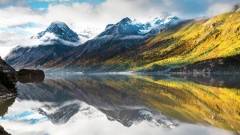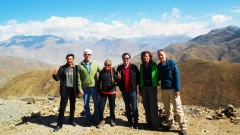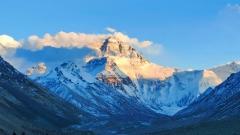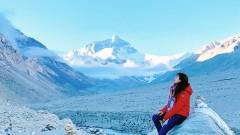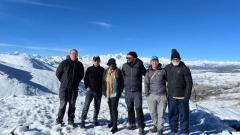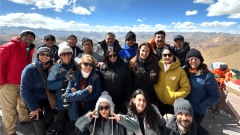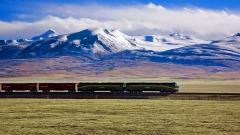Far in the southeastern corner of Tibet, where snow peaks meet crystal lakes and untouched valleys, lies Laigu Glacier — one of the most stunning and least-visited glaciers in China. Hidden within Bomi County of Nyingchi Prefecture, this icy wonder is a natural masterpiece shaped over millions of years. Unlike the crowded tourist spots of Lhasa or Namtso, Laigu offers a rare opportunity to witness Tibet’s raw wilderness and tranquil beauty.
For photographers, adventurers, and nature lovers, Laigu Glacier is more than a destination — it’s a breathtaking encounter with the living soul of the Himalayas.
Where Is Laigu Glacier?
Laigu Glacier (来古冰川) is located near Ranwu Town (然乌镇), about 90 kilometers from Bomi (波密) and roughly 360 kilometers from Nyingchi (林芝) city. Sitting at an altitude of about 3,800 meters, it forms part of the Midui Glacier cluster, a region famous for its complex glacier systems.
The surrounding Laigu Village is one of Tibet’s most beautiful villages, overlooking five glaciers and Ranwu Lake, whose turquoise surface mirrors the snow-covered peaks.

Laigu Village
What Makes Laigu Glacier So Special?
A Living Glacier System
Laigu Glacier isn’t just one glacier — it’s a cluster of five major glaciers extending from the Gangrigabu Mountains, including Midui, Xialong, and Laigu main glacier. The ice tongues stretch down from snow peaks over 6,000 meters high, forming deep blue crevasses, ice caves, and frozen waterfalls.
Unlike many glaciers that are receding rapidly, Laigu still maintains an impressive active flow, meaning you can actually hear and see the glacier shifting and cracking — a thrilling experience for visitors.
A Rare Blend of Ice and Life
What makes Laigu truly unique is the contrast of ice and greenery. In winter, the region turns into a silver-white wonderland, while in spring and autumn, the glaciers gleam against golden forests and blue lakes. Below the glaciers lie fertile valleys where barley fields and Tibetan villages thrive — a harmony of nature few places on Earth can offer.
The Best Time to Visit Laigu Glacier
While Laigu Glacier is accessible year-round, the best time to visit is from November to March. During this period:
-
The skies are clear and dry, offering excellent visibility.
-
The glacier retains its bright blue color, perfect for reflection photography.
-
Ranwu Lake often freezes partially, creating magical ice patterns.

Laigu Glacier
Spring (April–May) brings melting snow and wildflowers, while autumn (September–October) surrounds the glacier with golden forests. Summer, though lush, can be cloudy and rainy, sometimes limiting visibility.
Things to Do at Laigu Glacier
1. Glacier Hiking & Photography
The best viewpoint is a short trek from Laigu Village, where you can see multiple glaciers in one panorama. For photographers, early morning and late afternoon are ideal — sunlight makes the ice shimmer in shades of blue and silver.
Bring a wide-angle lens to capture the full scale, and don’t miss the mirror reflection on Ranwu Lake when the wind is calm.
2. Visit Laigu Village
This small Tibetan village is known for its stone houses, prayer flags, and sheep herding culture. Locals are warm and friendly, and some families offer homestay experiences, where you can taste yak butter tea and traditional barley wine.
3. Enjoy Ranwu Lake Views
Ranwu Lake is one of Tibet’s most photogenic lakes, especially when its calm surface reflects the glaciers. The upper and lower Ranwu Lakes have slightly different colors — one turquoise, the other sapphire blue.

Ranwu Lake
4. Explore Nearby Midui Glacier
If you have extra time, travel about 20 km west to Midui Glacier, often called the “most beautiful glacier in China.” It’s more developed and easier to access, making it a great contrast to Laigu’s untouched wilderness.
How to Get to Laigu Glacier
By Air and Road
The nearest airport is Nyingchi Mainling Airport (LZY), with direct flights from Chengdu, Chongqing, and Lhasa.
From Nyingchi, you can take the scenic G318 National Highway to Bomi and then continue south to Ranwu and Laigu Village. The drive takes about 8–9 hours, but every turn offers postcard views of mountains, forests, and lakes.
By Overland Route from Lhasa
Travelers can also reach Laigu via the Lhasa–Bomi–Ranwu route, covering around 700 km in total. This route passes through Basum Tso Lake and the Sejila Pass, making it a classic Tibet photography circuit.
Accommodation and Travel Tips
-
Where to Stay:
-
Laigu Village Homestays — cozy Tibetan-style homes with lake views.
-
Ranwu Lake Hotels — better facilities and heating, ideal for winter visits.
-
-
Altitude: 3,800–4,000 meters. Acclimatize in Nyingchi or Bomi before visiting.
-
Clothing: Even in spring, temperatures drop below freezing at night. Bring thermal wear, gloves, and windproof jackets.
-
Transportation: Roads can be icy in winter; hiring an experienced Tibetan driver is recommended.
-
Responsible Travel: Do not walk onto the glacier without a guide — cracks and ice caves can be dangerous.
Why You Shouldn’t Miss Laigu Glacier
Laigu Glacier isn’t just a sightseeing spot — it’s a reminder of how powerful and fragile nature can be. Standing before its shimmering ice walls and hearing the low thunder of cracking ice is an experience that words can hardly capture.
If you dream of seeing Tibet’s purest landscapes without crowds, Laigu is your answer — a destination where time slows down, and every view feels untouched by the modern world.
Conclusion
Laigu Glacier is one of those rare places that feels truly sacred — not just for Tibetans, but for anyone who loves nature in its rawest form. Between ice, mountains, and blue lakes, it reveals a side of Tibet few travelers ever see.
Whether you’re chasing perfect photos, adventure, or peace, Laigu Glacier will leave you breathless — both literally and spiritually.



